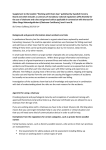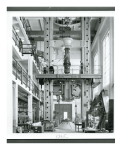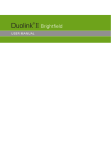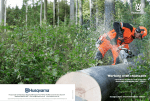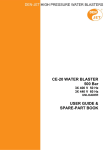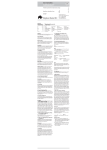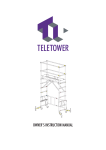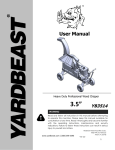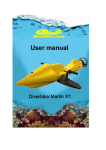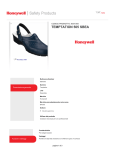Download 1 Supplement to the booklet "Röjsågning" published
Transcript
Supplement to the booklet "Röjsågning" published by Swedish Forestry Board and which includes a summary of mandatory national regulations (AFS 2012:01) for the use of brush saws and rules and general advice applicable in connection with the test for Säker Skogs Röjsågskörkort (Brush Saw Certificate), level RA (also RT) and RB. By Tomas Gullberg 2013-01-14 Background and general information about accidents and risks Brush saws are widely used in forestry for cleaning and spacing of juvenile stands and for cutting of undergrowth before harvesting operations. It is also commonly used for management of parks and recreational areas in urban environment. The most serious accidents when working with brush saws are usually injuries caused by the cutting blade. It happens that the operators get too close and accidentally cuts each other in the legs. The operator may also cut himself when cleaning the blade and blade guard from debris. Always remember to turn off the brush cutter before cleaning the blade. You may also cut yourself if you slip and fall over the blade. Other severe accidents may happen if the blade cracks and kicks away metal particles or other objects. It has also happened that operators have been attacked by aggressive bears or more commonly by angry wasps. An increasing problem is also the risk of infections from contagious ticks. The most common accidents are eye injuries and tripping accidents. Eye protection and shoes with good grip and appropriate clothing is important to use. Fatal accidents when using brush saws are extremely unusual, although there are many serious accidents. Age-limit for using a brush saw Providing physical and psychological maturity and completion of vocational training with approved theoretical and practical tests (e.g. Brush Saw Certificate) you are allowed to use a brush saws from the age of 16. If you are working alone with a brush saws you have to be at least 18 years old. Working alone means that you cannot get immediate help in case of an accident or critical situation and that you will need some kind of communication device in order to call for help. Exemptions from the regulations for certain categories, such as private forest woodlot owners Family business owners, such as forestry woodlot owners, who works on their own premises are exempted from: The requirements for safety analysis and risk assessment including follow-up. The ban on working alone in certain types of work. The requirements for work instruction and a routine for communication between workers. The requirement for a separate brush saw room. The requirements for proper knowledge and training. At construction work or when you are working together with other people (not family) or on others people’s property, the requirements for knowledge and training is mandatory also for self-employed people. 1 Safety analysis and risk assessment Safety issues at different work situations have to be assessed and all necessary measures have to be taken to prevent illness or accidents. The following shall be taken into account: The workers' theoretical and practical knowledge. The risks associated with labor hiring and temporary employment. The maintenance and service of equipment. The safety equipment. The user manual from the manufacturer (e.g. concerning safety checks and maintenance as well as approved cutting equipment). Particularly hazardous work. Particular safety issues when working alone. The safety analysis and implemented measures should be monitored and updated regularly. If acceptable light conditions cannot be arranged in the workplace, i.e. you are working during dusk and nights, further work should be stopped. Technical safety requirements for brush cutters New brush saws must be CE marked and adhere to the requirements in EU’s Directive for Machinery. Older, not CE marked, brush saws must have the following protective devices (which basically are standard equipment on all new brush saws): Blade guard that reaches 10 mm below the cutting plane and at least 90 degrees toward the operator (the same specification also applies to grass cutters and trimmers). The brush saw must be used with a harness which distributes the weight evenly across the shoulders and be equipped with a quick safety release mechanism on the brush saw or the harness. Start and stop device. Clutch which disengages the blade at idle. The length of the drive shaft must be at least 110 cm, from the suspension point on the drive shaft and harness to the closest cutting tooth on the blade. It is also important that the de-vibration system and the muffler is functioning. A harness with waist belt provides improved ergonomics since the weight on the shoulders can be eased. When trimming grass the cutting tool should be positioned flat and close to the ground. For forestry cleaning the blade should balance 20-40 cm above the ground and lean slightly forward. Check user’s manuals for basic adjustments in terms of recommended handle adjustment, elbow angles, suspension height, saw blade balance etc. It is important to understand all adjustment options that are available on the harness and brush saw. The cutting equipment must be controlled regularly for damage and wear. Check for cracks by looking carefully and by listening to the "sound" by knocking on the blade with a metal pin. It is recommended to change the blade when the cutting teeth are less than 5 mm (manufacturer’s recommendation but no legal requirement). The blades safety locking nut should be replaced regularly or when it is damaged. Always use correct blade and trimmer guards for different types of cutting tools. 2 It is important not to use accessories and cutting tools which are not approved by the manufacturer. Cutting heads with chain links are prohibited. Correct sharpening and maintenance of the cutting equipment is important for your safety. Proper top plate angle and blade setting is required to make an effective and controlled cut. A too big top plate angle increases the risk of kickback and uncontrolled cutting. Mandatory rules and recommendations for the use of brush saws When there is no daylight you should either stop to work or arrange for acceptable light conditions covering the entire work area. When working indoors you should arrange for satisfactory ventilation (except for firefighters using breathing apparatus). When transporting brush saws and fuel in vehicles, you and all passengers should be protected from fumes, explosion and fire. Anyone who works with a brush saw should be protected from falling objects, fumes, vibration, noise, cuts etc. Safety control The brush saw including the cutting attachment should be controlled periodically by a person with good knowledge about safety devices, use and care. Daily safety checks shall be carried out on brush saws in use. All employees working with brush saws should be trained for the type of work they are doing and have proper skills for the job. Accidents at work with brush saws are often due to deficiencies in the working techniques and the assessment of risks that may arise during the work. It is therefore important that the operator has a good knowledge of different tasks and is able to use the right technique for any possible work situation. Personal safety equipment When working with a brush saw the following personal safety equipment shall be used: Hearing protection (protective covers) Safety helmet Eye protection / visor (to protect from scratches, flying chips and saw dust) Protective boots with steel toecap and cutting protection (at least class 1) Work gloves Visibility clothing (CE EN 471) on the upper body Note that protective boots designed for chainsaws do not give a complete and safe protection from cuts with a cutting blade. It is possible to make exemptions from the one or some of the personal safety items after risk assessment and documented safety analysis. Exemptions are not allowed to do when you carry out tree felling. When working with a brush saw, the brush saw operator shall always carry a first aid kit. When trimming grass it is recommended to use a Plexiglas visor to protect your face from accidentally being sprayed with dog and cat shit. When trimming grass near gravel roads and walking tracks observe the risk for flying gravel and small particles which could pose a danger to passing people. Always stop to work if someone is passing by in the working area. 3 Plastic safety helmets have a limited lifetime due to the exposure of sunlight, heat and different kinds of solvents. The manufacturer usually guarantees its function for about 3 years but normally it lasts at least 5 years with proper maintenance. Be sure to regularly check the function of the hearing protectors including the sealing rings and noise absorbers. It is easy to get injured during work with brush saws due to tripping and slipping. The risks can be reduced by using boots with non-slipping sole, suitable clothing and good planning. According to the Swedish Occupational and Safety Act the employer must provide safety equipment for all employees. During forestry work the operator must always organize some kind of communication with a designated person. It is important that fuel do not cause illness or disorders for the operator or the environment. It is recommended to use bio fuel to reduce harmful emissions. Bio fuel also has better storage characteristics and can usually be stored for years. Starting the brush saw Several starting methods are allowed. The preferred method is to position the brush saw on the ground and with the cutting attachment able to rotate clear of the ground and any objects. Press one hand on the engine to support the brush saw and pull the starting rope. Other methods to start the brush saw, i.e. connected to the harness, is allowed as long as you have full control and oversee the cutting attachment. After refueling the brush saw it should be moved to reduce the risk of fire. Running the brush saw Always work with safety in mind. The brush saw must always be hooked to your harness. Avoid unnecessary movements and cutting. Turn off the engine if you move longer distances. For best control when cutting you should maintain a good stance and manoeuver the brush saw with both handle and body movements. Always maintain a high speed on the blade before you start to cut through the stem and make sure your blade is well sharped and set. Avoid to use the kick-back sector, between 12- 3, when you cut stems thicker than 3 cm. Sector 8-12 provides the best control and you may cut with full accuracy. During sweeping movements, cutting thin and dense vegetation, try to move the blade from right to left, cutting with the left side of the blade. Note that it is recommended to vary the engine speed and torque to reduce the risk of engine damage from prolonged work at full speed, especially during grass and sweep cutting. Tree felling During tree felling close to buildings, recreational areas and in other areas with people, it is important to put up warning signs at all access roads. Only the feller is allowed to work within the reach of the tree. The safety distance is 15 meter. The felling shall be stopped if someone else enters the area. Before you begin to fell a tree 4 you must have planned and cleaned an escape route. This will enables you to put yourself in a safer position when the tree falls. Directional felling of single cut stems (max 6 cm) The main principle for directional felling is to get the tree butt end to slide off the blade in the opposite direction that you want the tree to fall. A high stump makes it easier to control the direction of fall. Cutting on the blade's left side fell the trees forward while cutting on the right side fell the trees backwards due to the rotation of the blade. By tilting the blade combined with a pushing movement the trees can be felled in different directions. To fell straight sideways it is important to push quickly. When you have a wind factor or leaning trees the work should be planned accordingly and the trees mainly felled in their natural lean. Directional felling of double cut stems To fell a double cut tree (bigger than 7-8 cm in diameter) sideways, make overlapping cuts from each side, roughly 10 cm apart in height, then push down the tree by hand. If it might require some more power to force the tree to fall, the first cut should be made on the pressure side and the last cut higher on the tension side. This will form a supporting "shelf" to push against. Otherwise, longer trees could break and fall in its lean. Trees to be felled straight forward or straight backwards should be cut with two cuts at the same level, from the right and left side, leaving a "hinge" in the direction of the fall. For the best control, make the last cut with the left side of the blade. Push down the tree by hand. Sporadic large trees can be felled by a hinge. Begin by cutting the top cut in the notch flat and the lower cut leaning upwards. Then walk around and cut the felling cut. All cutting should be done with the left side of the blade. Hanging trees Hanging trees are usually easiest to bring down by cutting them into shorter pieces until they fall down. Bouquets The blade gets easily stuck when cutting in a bouquet. Begin by “open up” the bouquet quite high up to release the tension and weight of the stems. Once the bouquet got an "opening" the other trees can be cut from the inside. Trees in tension and heavy leaning trees Trees in tension may pinch your blade, split or kick backwards. Never stand on the outside of the bend, where you can be hit by a kicking stem. Cut leaning, single cut trees, from the side and behind and slightly upwards (minimizes the risk of pinching the blade). Heavily leaning, double cut stems, should be cut from the side, first 5 slightly on the pressure side and then on the tension side and lower. If the last cut is placed above, there is a risk the blade get stuck and damaged. Work along power lines When you are felling trees close to power lines, always contact the owner before the work begins. When a tree is leaning towards the power line or is hanging into the power line, the power must be turned off by the owner of the power line before the work begins. 6






